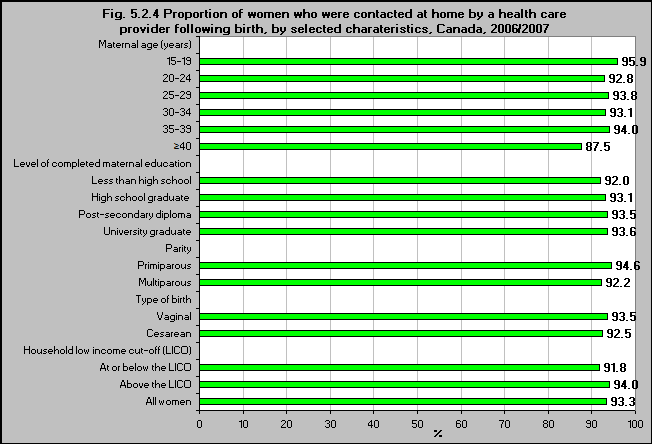Proportion of women who were contacted at home by a health care provider following birth, by selected characteristics, Canada, 2006/2007

Notes¹:
Parity: the number of live births a woman has had to date.
Primiparous: a woman who has given birth one time.
Multiparous: a woman who has given birth two or more times.
Source: CICH graphic created using data adapted from the Public Health Agency of Canada. What Mothers Say: The Canadian Maternity Experiences Survey 2006-2007. Ottawa. 2009.
http://www.phac-aspc.gc.ca/rhs-ssg/pdf/tab-eng.pdf -accessed July 24, 2017.
Women having their first babies were somewhat more likely to be contacted at home by a health care provider compared with women having subsequent babies in 2006/07.
Women with less than a high school education were somewhat less likely to be contacted than were women with a university degree.
Women living above low income (as defined by the LICO- low income cutoff) were somewhat more likely to be contacted than were women living at or below the LICO.
Teenage women were most likely to be contacted among all women of all age groups.
On average, women were contacted 7 days after birth. That varied from 4 days in Alberta, 6 days in British Columbia to 15 days in New Brunswick, 11 days in the Northwest Territories and 9 days in Nova Scotia.1
1Public Health Agency of Canada. What Mothers Say: The Canadian Maternity Experiences Survey 2006-2007. Ottawa. 2009. http://www.phac-aspc.gc.ca/rhs-ssg/pdf/tab-eng.pdf-accessed July 24, 2017.
Implications
It is encouraging that teenage women were more likely to be contacted by a health professional, since we know that while teenage moms can be at higher risk of problems, with adequate support many of these problems can be mitigated. There is evidence that home visiting programs with teenage moms have positive impacts on both mothers and babies/children.2 However, it is somewhat worrisome that women living in low income and those will lower levels of education were less likely to be contacted – as they are at higher risk of having problems.
2 Olds, D. L. (2006), The nurse–family partnership: An evidence-based preventive intervention. Infant Ment. Health J., 27: 5–25.
